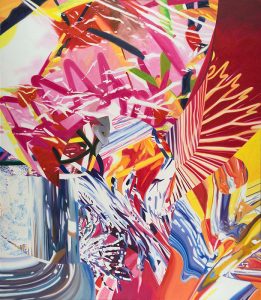
James Rosenquist, Pop Eye- Speed of Light, 2001, Oil on canvas, 76 x 66 in., Gift of Sydney and Walda Besthoff, 2008.140
The art world lost a defining figure from the Pop Art Movement of the mid-20th century with the death of James Rosenquist on March 31, 2017. Rosenquist, born in Grand Forks, North Dakota, in 1933, was employed as a Times Square billboard painter in his younger years. This exposure to splashy mass-marketing heavily influenced his paintings that would appear on museum walls the world over.
An obituary from the New York Times explains, “It was while working in New York as a sign painter by day and an abstract painter by night that he had the idea to import the giant-scale, broadly painted representational pictures from outdoor advertising into the realm of fine art.”
In a 2003 review of a Rosenquist retrospective at the Guggenheim Museum, New York Times critic Michael Kimmelman wrote, “The art’s formal ingenuity can jump out at you as forcefully as the grill of a Ford or a fragment of Marilyn Monroe’s lips or the cap from a Pepsi bottle or a stack of Fiesta dishes in a dish rack.”
Rosenquist’s autobiography, Painting Below Zero: Notes on a Life in Art, written with David Dalton, was published in 2009. In this memoir, Rosenquist wrote, “Andy Warhol, Roy Lichtenstein, and I are so often mentioned in the same breath you’d have thought we all lived together in some abandoned amusement park…What united us, you might say, was dread of the drip, the splash, the schmear, combined with an ironic attitude toward the banalities of American consumer culture. If anything, you might say were were antipop artists.”
NOMA’s permanent collection includes two paintings and eight prints by Rosenquist. His Pop Eye – Speed of Light appeared in the 2015 exhibition Visions of US: American Art in 2015. Rosenquist cites Albert Einstein’s theory of relativity as the inspiration for his Speed of Light series. The renowned scientist posited in 1915 that someone traveling in space at or near the speed of light would have a very different experience of time and distance relative to a slower-moving observer on earth.
“I want people who look at my paintings to be able to pass through the illusory surface of the canvas,” Rosenquist wrote, “and enter a space where the ideas in my head collide with theirs.”